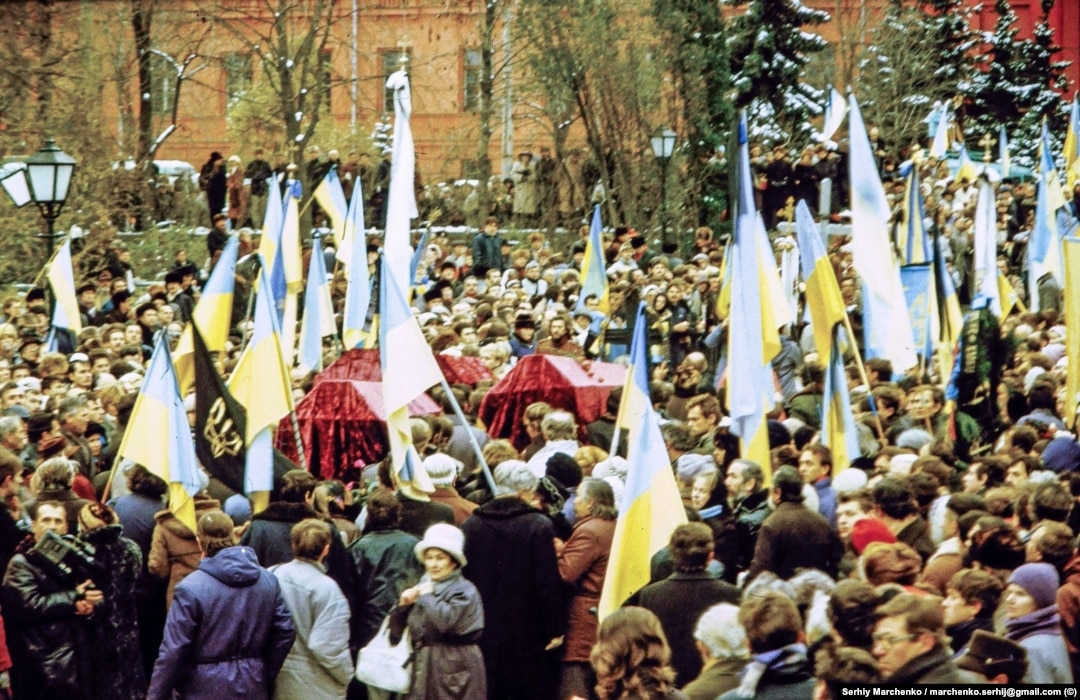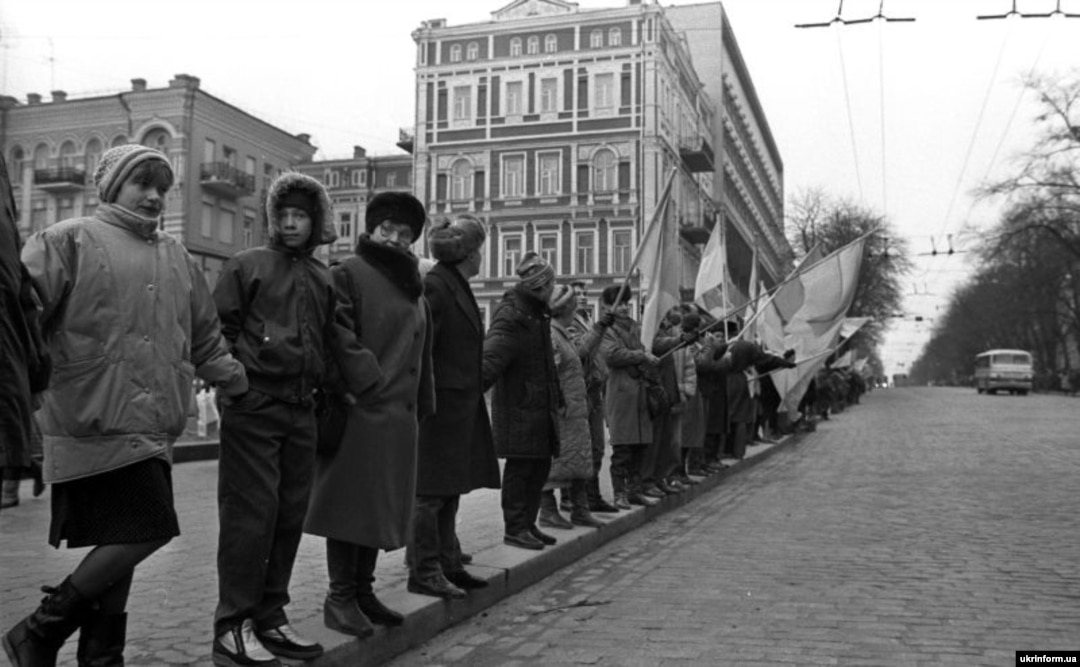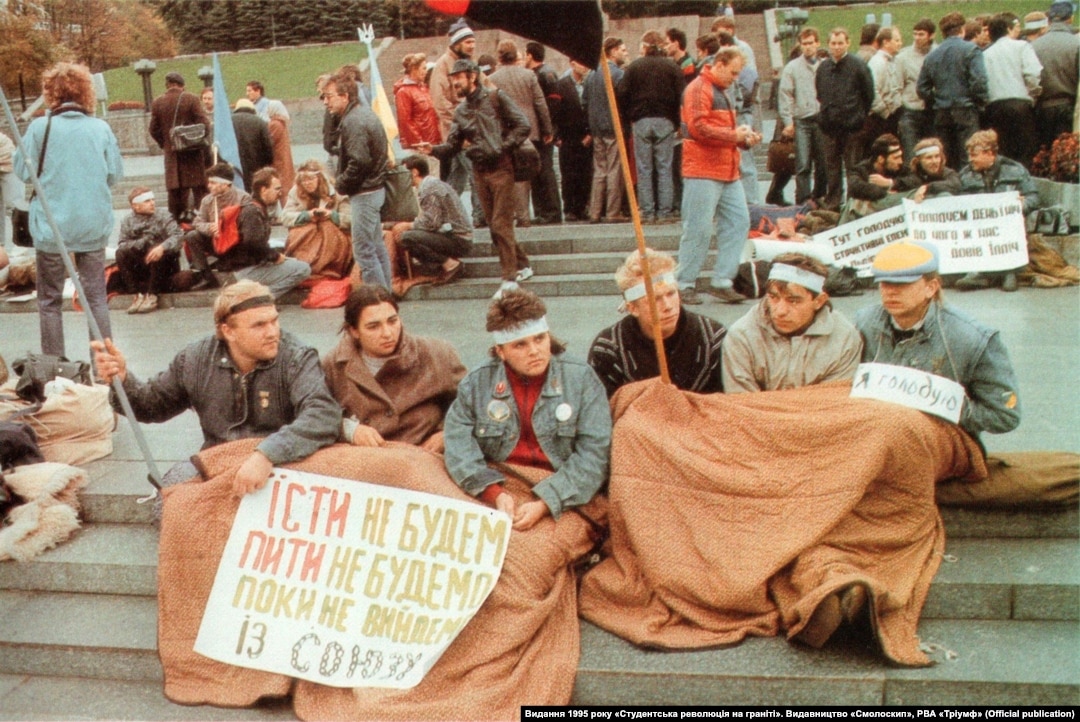In Pictures: Ukraine’s Path To Independence In 1991

Crowds wearing Ukraine's national colors demonstrate in front of the Communist Party headquarters in Kyiv in August 1991. During the Soviet era, expressions of Ukrainian linguistic, cultural, and religious identity were suppressed. Ukrainians were sometimes killed, imprisoned, or exiled for the simple reason that they were thought to be in favor of Ukraine's independence.

Dissidents paid an especially heavy price, such as Vasyl Stus, Yuriy Lytvyn, and Oleksa Tykhyi, who were reburied (pictured) in Kyiv on November 19, 1989, with the then-banned Ukrainian flag proudly displayed. The three died while serving time for various crimes including "anti-Soviet activity" and "anti-Soviet agitation and propaganda."

On January 21, 1990, 3 million Ukrainians joined hands to form a human chain, the "Ukrainian Wave," from Lviv to the capital, Kyiv (pictured), to commemorate the 71st anniversary of a short-lived Ukrainian republic established in 1919. It was the largest demonstration in late-Soviet Ukraine.

Elections in March 1990 fractured the Communist Party's monopoly on power in Ukraine. Months later, as Soviet President Mikhail Gorbachev sought to prevent the disintegration of the U.S.S.R., hundreds of thousands of people participated in protests and strikes across Ukraine calling for independence.
The "Revolution on Granite" (pictured), was a student protest held that year in October, centered on Maidan Nezalezhnosti (Independence Square), in Kyiv.
On August 1, 1991, U.S. President George Bush delivered his "Chicken Kiev" speech, in which he warned Ukrainians about the dangers of "suicidal nationalism," a phrase used by Gorbachev. He further exhorted them to remember that "freedom is not the same as independence." Four months later, Bush reversed course when he was forced to recognize an independent Ukraine.
Bush (left) and the chairman of Ukraine’s parliament, Leonid Kravchuk, during talks on August 5, 1991.
An attempted putsch was launched between August 19 and August 22 by hard-line communists seeking to overthrow Gorbachev and reverse his reforms. Their efforts faced popular resistance and quickly collapsed. In the chaotic days that followed, on August 24, the Ukrainian parliament declared the country's independence. The declaration was made subject to popular ratification by a referendum on December 1, 1991.
Ukrainians celebrated the August 24 proclamation by tossing former political prisoner Levko Lukyanenko into the air. Lukyanenko was one of the founders of the Ukrainian Helsinki Group in 1976. He was also a co-author of the 1991 independence declaration.
The first direct presidential elections in Ukraine's history were to take place on December 1, 1991, the same day as its independence referendum.
A supporter of presidential candidate Kravchuk holds his campaign poster in Kyiv on November 30.
A campaign worker holds up a newspaper that says "For a Free Ukraine" in Kyiv.
A supporter carries a campaign poster for former dissident Lukyanenko, now a presidential candidate, in Kyiv.
Both Ukrainian and European flags are seen during a pro-independence rally in Kyiv.
The historic ballot contains the question: "Do you confirm the Act of Proclamation of the Independence of Ukraine?" with two possible answers: "Yes, confirm" or "No, do not confirm."
Ukrainians cast their ballots in Kyiv on December 1, 1991.
Vyacheslav Chornovil was surrounded by members of the press in Lviv as the nation voted. Chornovil was a prominent Ukrainian politician and Soviet dissident who had founded the Popular Movement of Ukraine, which had pushed for reforms and more sovereignty. After years of political persecution and multiple arrests, he was able to run as a candidate for president.
Voters wait patiently to cast their ballots at the Kalinin mine in Donetsk, eastern Ukraine.
Voters in Odesa sign in to receive their ballots.
Lukyanenko signs in to cast his vote.
Cadets at a polling station in Kyiv.
Serhiy Hodorovskiy (right) watches as his grandmother, Rosa Hordorovskaiya, 80, casts her ballot in her Kyiv home. Rosa was too old to walk to the polling station, so the ballot box was brought to her.
Under the watchful gaze of Taras Shevchenko, voters cast their ballots. Shevchenko's literary legacy is widely regarded as the bedrock of modern Ukrainian literature and, to a large extent, the modern Ukrainian language.
Kravchuk casts his vote in Kyiv. Kravchuk would receive 61.6 percent of the votes and become Ukraine's first president. He was followed by Chornovil with 23.3 percent.
The turnout in the election was 84 percent and the vote was overwhelmingly for independence. More than 90 percent voted in favor. In Crimea, the pro-independence vote was 55 percent.
On December 8, 1991, Ukrainian President Kravchuk (second from left), Belarusian Supreme Soviet Chairman Stanislav Shushkevich (third from left), and Russian President Boris Yeltsin (second from right) signed a declaration that "the Soviet Union as a geopolitical reality [and] a subject of international law has ceased to exist."

